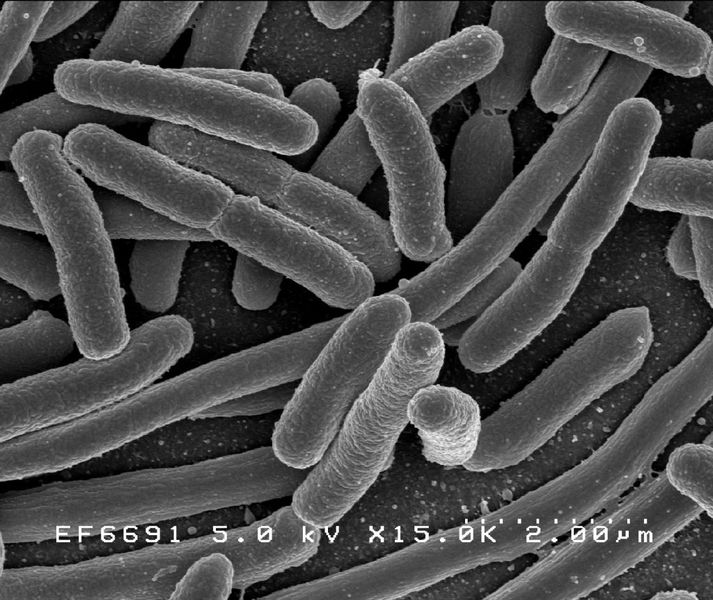Colibacillosis
Colibacillosis

Electron micrograph of E.coli bacteria Source: Rocky Mountain Laboratories, NIAID, NIH
Colibacillosis is an infectious disease caused by the bacterium Escherichia coli (also known simply as E. coli), and is seen in poultry flocks worldwide. E. coli can cause an infection under the skin, known as cellulitis, and is commonly associated with respiratory disease in birds, which in severe cases leads to septicaemia and death. Avian colibacillosis primarily affects broiler chickens between the ages of 4 and 6 weeks and is responsible for a significant proportion of the mortality found in poultry flocks. This mortality, treatment of the disease and decreased feed conversion efficiency result in significant costs to the poultry industry.
Symptoms
Signs of colibacillosis are respiratory distress, reduced appetite and poor growth. Lesions seen at post mortem are airsacculitis, pericarditis, perihepatitis and peritonitis. Figures 1, 2 and 3 illustrate the clear airsac of an uninfected bird, the foamy exudate seen early in infection, and the caseous exudate later in infection.
 |
 |
 |
E. coli are gram negative facultatively anaerobic (can be both aerobic an anaerobic depending on environmental conditions) bacilli that are part of the normal intestinal microflora of poultry. Although most E. coli are non-pathogenic, some strains are able to establish themselves outside of the intestines and cause disease. These strains are known as Avian Pathogenic E. coli (APEC). High numbers of E. coli are maintained in the poultry house environment through faecal contamination and the common route of infection is inhalation of the faecally contaminated dust that contains large numbers of pathogenic E. coli.
Predisposing Factors for Colibacillosis
Respiratory disease attributed to infection with E. coli is most commonly seen after respiratory stress caused by infections with Mycoplasma gallisepticum or viral agents such as infectious bronchitis virus (IBV) and Newcastle disease virus (NDV). Environmental influences, such as temperature, humidity, and high concentrations of ammonia and dust in poultry houses, also contribute to the respiratory stress of birds.
Virulence Factors Encoded on a Plasmid
Strains of Avian Pathogenic E. coli are known to possess specific virulence factors that are commonly carried on a large virulence plasmid. Many factors have been associated with the virulence of these E. coli strains, including the production of colicin V, resistance to serum, temperature sensitive haemagglutination and adhesins. Adherence to epithelial cells is a fundamental requirement for colonisation of the respiratory tract by E. coli. Iron scavenging mechanisms are thought to be one of the more important factors, as iron is essential for bacterial growth and therefore the establishment of infection. Numerous systems exist for iron acquisition, most of which are plasmid encoded. It is believed that a combination of these factors increases the pathogenicity of E. coli.
Diagnosis of Colibacillosis
Colibacillosis causes typical pathology, which can be seen during post mortems of affected birds. Isolation of a pure culture of E. coli from the heart, liver or other lesions confirms the diagnosis.
Control and Treatment of Colibacillosis
Control measures taken to prevent E. coli infection in chickens primarily involve elimination of predisposing factors, which includes vaccinating birds against mycoplasmas, IBV and NDV. E. coli is susceptible to disinfectants and temperatures greater than 80oC, so thorough cleaning of poultry houses, thereby reducing exposure to pathogenic strains of E. coli, can help. Ensuring proper ventilation and chlorination of drinking water also reduces the levels of environmental contamination. Treatment of colibacillosis relies on antimicrobial therapy, but with isolates of E. coli becoming increasingly resistant to frequently used antibiotics, this treatment may fail.
Further information
- Dho-Moulin, M. and J.M. Fairbrother, Avian pathogenic Escherichia coli (APEC). Vet Res, 1999. 30(2-3): p. 299-316.
- Doetkott, D.M., et al., Large plasmids of avian Escherichia coli isolates. Avian Dis, 1996. 40(4): p. 927-30.
- Gross, W.G., Diseases due to Escherichia coli in poultry, in Escherichia coli in domestic animals and humans, C.L. Gyles, Editor. 1994, CAB International, United Kingdom: Wallingford. p. 237-259.
- Knobl, T., et al., Virulence properties of Escherichia coli isolated from ostriches with respiratory disease. Vet Microbiol, 2001. 83(1): p. 71-80.
- Mellata, M., et al., Role of virulence factors in resistance of avian pathogenic Escherichia coli to serum and in pathogenicity. Infect Immun, 2003. 71(1): p. 536-40.
- Vidotto, M.C., et al., Virulence factors of avian Escherichia coli. Avian Dis, 1990. 34(3): p. 531-8.

